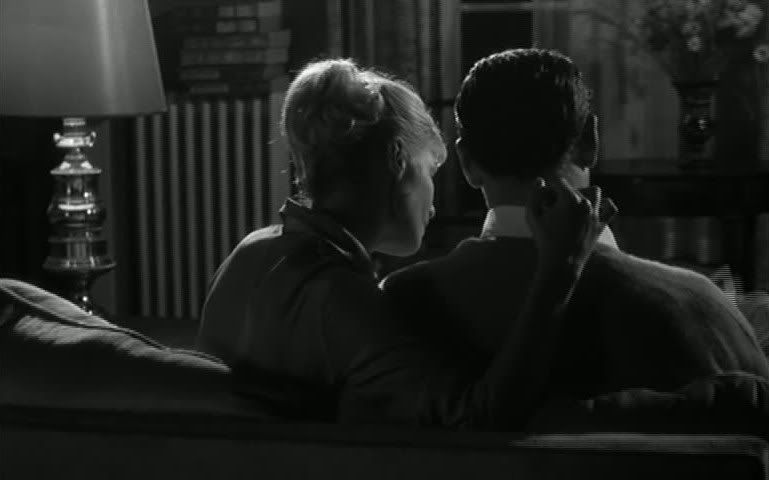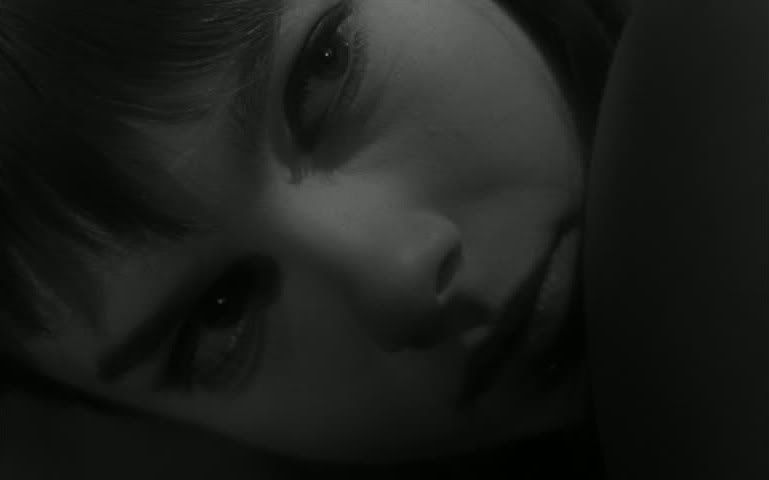
Alain Resnais' fourth feature, La guerre est finie, follows the radical aesthetics and unusual narrative structures of the director's first three features with a comparatively traditional tale of a Spanish political operative based in Paris and conducting missions intended to undermine the regime of the Spanish dictator Franco. Diego (Yves Montand) is a Spanish exile who operates under a number of aliases, working with an underground Communist organization mostly based in Paris, smuggling newspapers and propaganda into Spain while trying to organize strikes and revolutions to weaken Franco's regime. The film opens with Diego barely escaping from Spain back into France by using a fake passport, pretending to be a French businessman. When he's stopped at the border, the Spanish police call his supposed Parisian home and speak to his "daughter," Nadine (Geneviève Bujold), who vouches for him.
The film envisions political activity as an act of imagination and creativity, as something akin to the artist's creation of an alternate reality that replaces, at least in the domain of the aesthetic, the world outside the art. Diego is a revolutionary for whom this image has started to fade, to lose its appeal. He is no longer convinced that his activity is accomplishing anything, and he grows weary of endless conferences and secret meetings, endless trips across the border that accomplish little except moving paper from one place to another. His comrades, he believes, are living a fantasy, believing that their Paris-based organization can stir up the masses of Spain from outside, that they can dictate the day and time of Franco's downfall with their communiques. Diego has come to a more realist understanding of just how long it can take to effectively change the world, and his disillusionment weighs him down as he returns to Paris, visits his longtime girlfriend and lover Marianne (Ingrid Thulin), and becomes involved with Nadine, who's part of her own ring of activists with a more violent tactical agenda in Spain.
Over the course of the film, Resnais observes the debates and discussions among these underground factions and resisters, their conversations awash in the terminology of 60s radical politics: Leninism, self-criticism, revolution, the masses, general strikes and bombs to awaken a sleeping proletariat. The film's style is mostly straightforward, in crisp black-and-white, and the editing is not as jarring and jagged as it was in Resnais' first three features. The only exception is the occasional interjection of scenes that reflect the imagination of the protagonist, as Diego imagines what might've happened to some arrested friends, or what might happen at his next rendezvous. In one of the most striking of these insertions, Diego imagines a succession of women who might be the anonymous contact pretending to be his daughter: in his work as a spy, he is in the unique position of having false relatives who will help him from afar without ever meeting him. He can't help but wonder about the voice on the other end of the phone who's so intimate with him, so familiar, even though he has no idea what she looks like. He can only envision a woman walking along, her appearance changing with nearly every step.
Later, Deigo will actually meet Nadine, so that his image of her will coalesce into a particular woman. There follows a remarkable sex scene with Nadine in which Resnais references Godard's A Married Woman from a couple of years earlier. He chops the sex scene into discreet fragments: a shot of the man's hand on the woman's stomach, a shot of her hand clenched in his, a shot of her knees, and the sequence ends with a very suggestive shot of her legs slowly spreading apart, the camera slowly drifting down her legs, the shot cutting off just before reaching the inevitable destination. In Godard's film, this fragmentary collage of body parts suggested disconnection and dehumanization, but Resnais makes it lilting and lyrical, with a gentle drifting quality. Nadine, shot against a pure white background, seems to be levitating out of bed, floating into the air, an image of surprising sensuality, so that the encounter is anonymous but intense. It has the quality of an escape, of two people existing outside of space and time, in a white void removed from the world, and thus removed from the realities of Diego's constant revolutionary struggle, removed from his worries and the constant threat of arrest or death.

In contrast, when Diego returns afterward to his home with Marianne, it is as though he has crashed back to reality, and the weight of his revolutionary's life comes crashing back onto him. With Nadine, he'd affected yet another false name, calling himself Domingo for "Sunday," while she called herself "Nana," an affectionate nickname given by her father, who Diego had been pretending to be for his latest mission. (And also a reference to Godard's Vivre sa vie.) They both have aliases, and it further enhances the impression that this encounter is an uncomplicated diversion, a dream of what being a spy is like; Nadine is charmed by Diego's false passports and what she probably imagines is an adventurous life as a "professional revolutionary," and her glamorous image of him is certainly a part of this dalliance. Marianne, in contrast, does not see the glamor; she gets to worry, to wonder when or if she'll see him again, and Diego's return to his home with her brings reality back into sharp focus. He's forced to interact awkwardly with her friends, telling lies about where he'd been. He walks into her young son's room and refreshes a chalk message on a blackboard while the boy sleeps nearby — it suggests that this is the only contact he has with the child, leaving messages in the night to let him know that he'd been here and thought of the boy, even if he was gone by daylight.
The subsequent sex scene with Marianne is then concrete and physical where the one with Nadine had been abstracted and lyrical. The scenes begin the same, with Diego caressing the women's backs, lifting their shirts to put his hands on their backs and stomachs, drawing a connection between his two women, the one who represents "reality" and the one who represents his spy alter-ego. The juxtaposition of these two scenes, one after the other, calls attention to the blurring of different realities. What's more "real" for Diego, his home life with his long-time girlfriend Marianne — who he doesn't see for months at a time — or his constant shuffling back and forth across borders, his name changing every time he meets someone new? As Marianne tells him, after they've made love, his life is in Spain, with his cause and his people. His real life is not this home, not the lies they tell about him being a translator traveling for his job, but the lies he tells as a spy.
There is also the reality of Franco's Spain as it is as opposed to the dream maintained by the revolutionaries, a dream of what Spain once was before Franco, and what it might be again if they are successful in their plans. In their own ways, revolution and resistance are also ways of denying reality, proposing and projecting a new reality to take the place of the current one. And in the case of these Spanish exiles living in Paris, they are projecting their reality from outside, like the cinema projects its beam through the dark and onto a screen. Diego and his comrades, in Paris, are the projectors, and the image they are projecting onto the screen of Spain is their own plan, their own vision of its future without Franco. Anti-fascist resistance becomes an act of imagination and fantasy, a way of denying the hard facts of reality in pursuit of a dreamlike vision of a possible future.







0Awesome Comments!